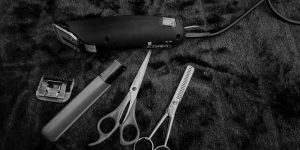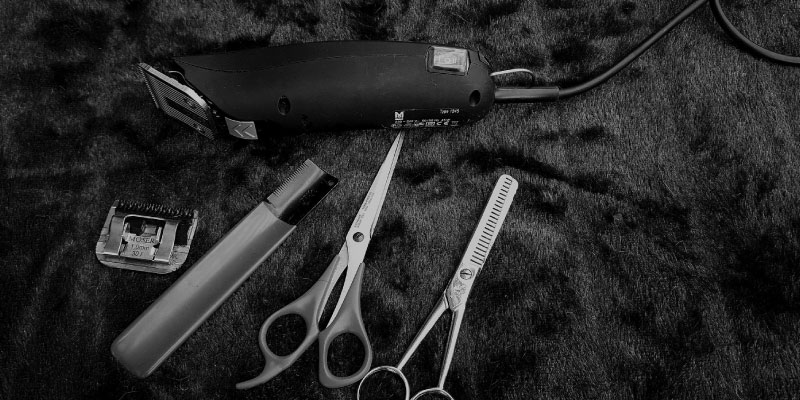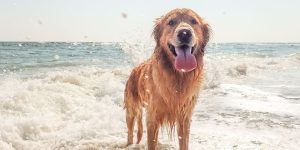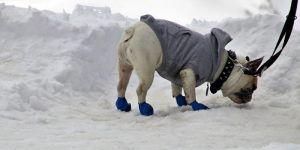In an ideal world, we would all send our dogs to a dog spa every 6 weeks. If that’s not on the cards, don’t worry: there’s plenty of ways to meet your dogs needs at home without all the fuss, pamper and costs.
We’ve all seen the adverts on minivans for dog grooming boutiques and salons – the images of perfectly preened pooches with luscious locks and bows in their hair.

As lovely as it is to pamper our pups, it can add up to a pretty penny! Some breeds have to be groomed, but most can be mostly managed at home, and all can get a little home-treatment; even poodles.
If you’re looking for a more cost-effective way to groom your dog, try our guide on how to groom a dog at home.
Why you need to groom your dog
Naturally, there will be some dogs that need grooming more than others.
Longer-haired dogs like Maltese, Shih Tzus and Yorkshire Terriers will all need their fur looking after – but there’s more to it than just the aesthetic value!
In fact, use the right dog grooming equipment and you could notice many benefits for your dogs. For example:
You’ll improve their circulation
Apply the right dog grooming techniques and you’ll gently massage your dog’s muscles, improving their circulation. This is especially important as poor circulation can lead to poor blood supply to their vital organs and muscles, or in worse cases, risk chronic valve disease.
You’ll notice fewer skin complaints
This is the same for dogs as it is for humans! By regularly brushing the fur, you distribute naturally occurring oils more evenly. This prevents build up in the sebaceous glands – the same glands that produce these oils. Just like this prevents dandruff in humans, it stops build-up for dogs.
If your dog isn’t groomed regularly, you may notice heavy wads of hair which weigh the skin down and result in rashes or discomfort. Lack of grooming may also result in sebaceous cysts.
You’ll form a better bond with your dog
As we said, it’s great to get your pooch pampered at the salon, but when you two sit down together for a good old groom, it can really enhance your bond. Your dog will begin to develop trust with you as you bring him/her comfort.
You can check on the general health of your pup
How often do you simply sit down and take a look at your pooch? This is your chance to take a look at the paws, tail and any problem areas, helping to identify matted hair, ticks or any other problems that may be causing pooch discomfort. The sooner you can spot them, the sooner you can get to the vet and get them sorted.
You’ll allow them to have a better grooming experience
Some dog breeds will need to regularly go to a grooming salon. But if you can maintain the work at home, you’ll ensure your dog isn’t overly stressed with the whole process when he is shipped off to a strange place, where they are washed, pulled and moved around. If they know how to handle being washed and having scissors or clippers near their skin, they are less likely to hurt themselves when they do eventually go to the groomers.
Dog grooming for beginners
So now you know why it’s so important to pay special care and attention to your dog, what do you need to groom? We’ve put together a list of the best dog grooming tools and techniques to help your pup feel pampered and special.
Set a time of day to groom your dog
Ideally you should be basic grooming your dog once a day, particularly if you’re out and about on walks and rolling around in all sorts of grass and mud!
Try to get into a routine by setting a specific time of day each time you groom, maybe a 8pm Netflix, Groom and Chill? Perhaps it’s first thing in the morning after your walk, or for a relaxing wind-down after work.
It doesn’t have to take long, 10 or 20 minutes depending on your dogs hair and needs.
However, if you’re going to do the whole grooming experience, from washing to cutting, and it’s the first time, set yourself an afternoon. Eventually you may do it in under an hour, but give yourself time so neither you or the pup get stressed.
Prepare your dog grooming essentials
For a really pampered experience, and to take care of your pooch’s health, you’ll need a number of tools.
Ask your vet if you’re not sure where to find these – but you should be able to find them at all reputable dog retailers. Your dog grooming kit will need:
- A fine comb (for dogs – not one from your collection!)
- Detangling spray – keep an eye on the ingredients list and ask your vet if you’re unsure about harsh chemicals
- A wider, metal comb
- Small scissors
- Clippers for dogs
- A small, slick brush
- Ear drops
- Eye/ear wipes
- A non-slip map to sit your dog on
- Dog shampoo (for bath times, which should only be once or twice a month max)
Be careful about which comb you use – it will depend on the breed of dog you have. Generally, coats fall into five different categories: silky, curly, double, wire and smooth.
Wire, double and curly coats will need sturdier combs, while you should be more cautious with smoother fur.
How can I groom my dog at home?
For a simple daily brushing routine, start by focusing on dead, tangled and matted hair. Begin to comb through from the head downwards, taking slow, careful motions to avoid discomfort if you do hit any knots.
You may need to build this up over a few weeks to establish more trust with your dog – particularly when it comes to sensitive areas. Be mindful that the tummy area is more sensitive than the rest, so go very easy here.
Focus on the easy parts. If you do see any heavily matted areas, come back to these at the end to minimise discomfort.
Ultimately, if some knots can’t be untangled, you may just need to cut the hair. No one but you and dog need ton know about the underarm bold patch.
Bathing your dog at home
Many pet owners find it easier to brush their dog once they’ve given pooch a bath. Of course, you shouldn’t need to do this every day, but if you have had a particularly long run around in the woods or notice a lot of matted hair, it can help to break down those knots.
Run a shallow bath and check the temperature constantly. A general rule of thumb is, if it’s too hot for you, it’s too hot for your pup. Invest in a premium dog shampoo, as cheaper brands may contain harsh chemicals that could be painful for your dog’s skin.
Rub the shampoo in gently, taking care to avoid your dog’s eyes. You can minimise drain clogs by putting down a hair snare. Alternatively, if yours is a large breed, it may be easier to bathe outside with a non-slip mat. Again, check the temperature of the water and watch out for any hazards like thorns/broken glass. Lay down some towels to minimise mess.
Dogs have naturally occurring oils that keep their skin and their hair healthy. Generally, most dog groomers won’t see dogs more than once a month, generally once ever 6 weeks, because you shouldn’t shampoo them more than that.
You can, of course, wash them down more often (in wintery/spring muddy walks, this may feel like an almost daily activity) but be spare with the shampooing.
It’s also why you can probably afford to go with a more high end dog shampoo brand – it will last you.
Cutting your dog’s hair
Your dog should always be completely dry before you attempt to cut its hair. Allow time to let it dry naturally. Scissors can be used for the face and ears, while clippers are safer for the rest of the body.
Always use clippers specially designed for dog grooming. If you’re not sure which grade to use, start with the smallest and work your way downwards. Most dogs get the perfect cut by adjusting the settings to a grade 10.
Important: Go down the body in the direction of the dog’s hair, and stop if you spot any skin complaints like a rash. Keep a close eye on the temperature of the blades too as these can get warm with extended use.
The clippers may get stuck in a knot, in which case you may need to use scissor to gut the knot before you can continue with the clippers, or use the clippers on a smaller setting to cut the knot out.
When cutting hair around the dog’s face and ears, ask a friend to help restrain your pup. In particular, hold the ears down and watch out for any sudden movements.
If in doubt, play it safe, and stay well away from the skin.
Finishing touches
Now that you’ve finished the biggest problem – matted and tangled hair – you can focus on really pampering your pooch.
You might notice occasionally that your dog has discharge around the eyes, in which case, eye wipes or a lightly moistened sponge can help. Always approach this area very slowly so as not to spook your dog. Never put the pad directly onto the eye – just around the duct to get rid of any excess fluids.
Be mindful of ‘tear stains’ which could be a sign of infection. These are easier to spot in light-haired dogs, but always ask your vet if you’re not sure. Don’t use shampoos near your dog’s eyes – just a lightly moistened sponge or specially designed eye wipe for dogs will do.
Occasionally, pup may need ear drops, for example if he/she is suffering from mites. In this case, your dog may not always be keen to cooperate! Again, go in slowly to establish trust. Fold back the ear and drop only the prescribed number of drops into the ear canal. Gently rub your dog’s ear to make them feel at ease.
What should I do if my dog gets nervous about grooming?
This is one of the top reasons for grooming your dog at home, beyond those mentioned above. You need to assure your dog that it’s in safe hands, particularly if it gets nervous.
To encourage good habits, build up your grooming routine slowly. You can reward your dog for sitting still by giving it treats (in moderation!). If yours is a really nervous dog, you might even want to considered veterinary approved calming aids or CBD oil.
Above all, stick to a routine. By having various people tend to your dog or a crowded room, this could spook your dog even more. Groom at the same time every day/bath at the same time every month, and go slowly.
You’ll both benefit from an improved bond and you’ll be able to spot any health problems more easily. At the end of the day, if your dog doesn’t trust YOU, their owner, to groom them, they won’t trust anyone else.
The occasional visit to a dog groomer is absolutely fine, but be mindful this can cost a minimum of £30 a go for small dog breeds. A good home grooming routine will look after your wallet, and more importantly, your dog.




